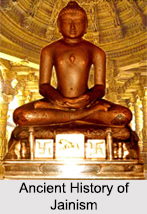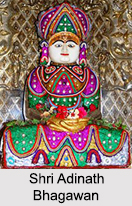 Ancient History of Jainism dates back to the time of Bhagwan Rishabh Dev or Adinath. He was the first of the 24 Tirthankaras and belonged to the House of Ikshwaku, also known as the “House of the Sunâ€. According to the Jain philosophy, Bhagwan Rishabh Dev was the first Tirthankara of the Avasarpini. The development of Jainism in ancient India is integrally related to the life and deeds of Adinath.
Ancient History of Jainism dates back to the time of Bhagwan Rishabh Dev or Adinath. He was the first of the 24 Tirthankaras and belonged to the House of Ikshwaku, also known as the “House of the Sunâ€. According to the Jain philosophy, Bhagwan Rishabh Dev was the first Tirthankara of the Avasarpini. The development of Jainism in ancient India is integrally related to the life and deeds of Adinath.
Ancient History of Jainism also includes the time period of Lord Mahavira, the 24th Tirthankara who formed the Jain Sangha. At the age of 30, Lord Mahavira gave up his corporeal life and activities. He spent most of his time in austerity and in meditation for almost 12 years. At the age of 42 years he achieved Nirvana.
Formation of Jain Sangha
As the last Tirthankara, Lord Mahavira formed a religious order or "Tirth" that comprised of monks, nuns, Sravakas and Sravikas. This order is known as the "Jain Sangha". His first follower was Gautam Swami who was a famous Brahmin scholar of the time. Bhagwan Mahavira had 11 Ganadhars who compiled 12 Holy Scriptures based on the teachings of Bhagwan Mahavira.
 For a century or so after the passing away of Bhagwan Mahavira, Jainism remained an insignificant denomination with no great following worth speaking. With Buddhism becoming much popular and attracting huge number of followers, Jainism could not come to the fore front but had a small but highly committed following of its own.
For a century or so after the passing away of Bhagwan Mahavira, Jainism remained an insignificant denomination with no great following worth speaking. With Buddhism becoming much popular and attracting huge number of followers, Jainism could not come to the fore front but had a small but highly committed following of its own.
Jainism during Maurya Rule
During this period, the Sangha survived because of the dedicated work of many spiritual leaders referred in the Jain texts as Gandharas. It was because of their efforts that the Sangha gained much recognition in the 4th century BC by the time the Mauryas came to power. According to history the first Emperor, the celebrated and legendary Chandragupta Maurya, became a Jain in the later part of his reign and died as a Jain monk.
Spread of Jainism
Bhadrabahu, a Jain monk of highest virtue, was instrumental in this conversion. Bhadrabahu persuaded Chandragupta Maurya to accompany him to the south during an impending famine in northern India. There they spread Jainism among the common masses. Chandragupta Maurya ended his life there, in the true Jain custom, fasting himself to death. At the same time, when Bhadrabahu was in the south with his devotees, a group of monks remained in the north, facing the famine, under the leadership of Sthulabhadra. Later Bhadrabahu proceeded to Nepal, where he died.
During the post Mauryan period, Jainism spread to South India for the dedicated work of the Jain monks who migrated to the south. Many south Indian kings got converted to Jainism and patronized the religion. Gradually Jainism also spread to the eastern coastal belt of India now constituting, parts of Andhra Pradesh and Odisha. In the west, in Gujarat, Jainism became famous mainly during the medieval period under the rule of Kumarapala. However, the invasion of the Muslims from outside affected Jainism especially in Gujarat and Rajasthan but it still survived because of the dedication and high degree of ascetic control of its monks.




















